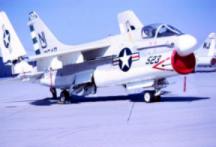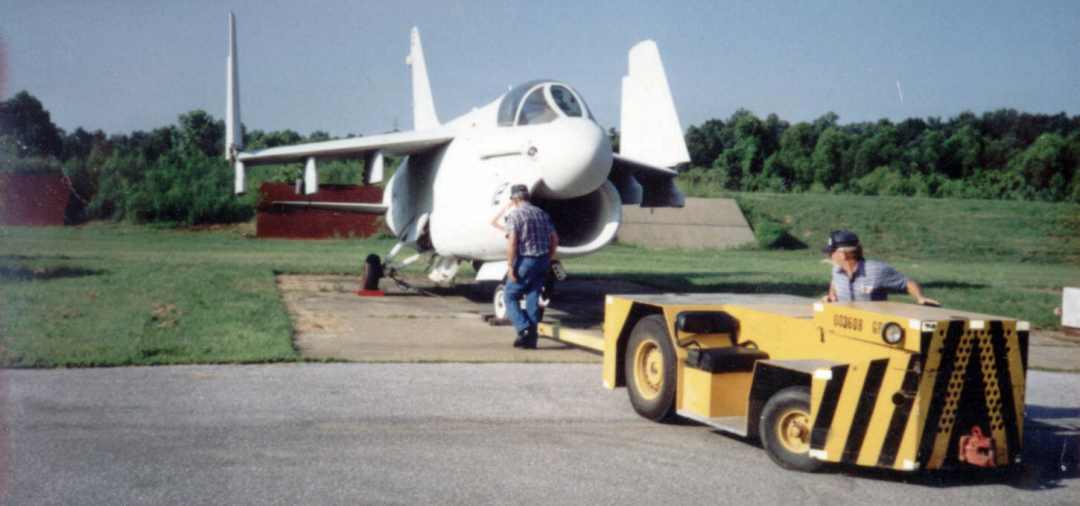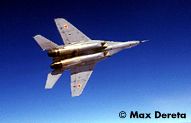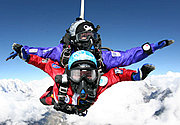| When you see an airplane
in a museum, you only see part of the story. This exhibit
is designed to give you the whole story of where the plane came from and
how much work was involved in getting the airplane from the military storage
area to the museum.
The first step is to find an airplane
that is available for museum use. You must have a lot of connections
and specialized knowledge to do this. This work was done by Mr. Chuck
Schumacher who is one of the most knowledgeable and nicest persons that
you will ever meet.
The second step is to get permission
to acquire the airplane. Again, you mush have the proper connections
and specialized knowledge for this.
The third step is to make arrangements
for disassembly, transportation, and reassembly of the aircraft.
Chuck used an aeronautical college to supply the manpower to disassemble
the airplane, in this case the
plane was located in Millington Tennessee at NAS (Naval Air Station) Memphis.
Using college students gave the students the great opportunity to learn
about
military aircraft while giving the museum a enthusiastic volunteer
force for the labor. The following gives a little information
about the airplanes history.
After a plane has been taken out of
service it is placed into storage.
This exhibit covers the history of
the A-7 and its recovery and restoration at the Prairie Aviation Museum, located
in Bloomington, Illinois. This A-7 Corsair II
jet fighter was originally
attached to VA-125, the Rough Raiders, stationed at NAS Lemoore near Lemoore
California which is about 32 miles south of Fresno. VA-125
was a training squadron using the A-7A and A-7B aircraft built by the Vought
Aircraft Company located in Texas. Once being attached to VA-125,
new pilots, fresh out of primary flight training, were now trained in the
type of aircraft that they will fly in the fleet operational squadrons.
This training was on the flight characteristics of the A-7, use of its
specialized avionics ( Aviation Electronics) and weapons systems, bombing
procedures, combat maneuvers and low level tactics in the mountains, not
to mention, of course, emergency procedures and fleet operations.
The A-7 was taken out of service in 1980 and replaced by the
F/A-18 Hornet.
The photo above was taken at NAS Memphis
in Millington, Tennessee
Webmasters
Note: This A-7 project was a special interest to me because I was
attached to VA-125 as an Avionics Technician and worked on this exact airplane
from 1974 to 1977. It's like visiting an old buddy from years ago.
I would like give special thanks to the people of the Prairie Aviation
Museum for allowing me to show these pictures on the website and giving
me permission to work on preservation and restoration of this aircraft.
This exhibit is brought to you with
special thanks to:
Graham Eich
who
did a tremendous amount of work scanning the pictures and as a liaison
between myself, C. Jeff Dyrek, and the Prairie Aircraft Museum.
Norm Wingham
, President and founder of the Prairie Aviation Museum.
Chuck Schumaker
,the person in charge of recovery and restoration of the A-7. Chuck
is also responsible for the recovery of the A-7 located at Chicago's Museum
of Science and Industry.
8/21/2007 I really enjoyed reading the saga about the
A-7A Corsair how you got one from
the Navy, restored it and put it in your museum. Brought back many memories for
me. I was an AZ with VA-37 (later VFA--37) Raging Bulls from 1989 to 1992. I
did one Med cruise with the Bulls on the
Forrestal just prior to Desert Shield.
I loved the A-7 too, and I just didn't believe the
F/A-18 Hornet was as good.
Anyway I really enjoyed reading about the restoration but I just have to correct
something I read. That is, A-7's from the 1980's had side numbers in the 300 and
400 series. Our planes had 300 series and our sister squadron (VA-105) had 400
series. Also our
A-7E side number 300 was referred to as Bullnuts. She was also
the CAG's plane, as all the planes with 00 in the Air Wing were his. The 500
series was on the
A-6's. Thanks for bringing back memories and I hope to visit
your museum one of these days. Take care and hope to see you soon Robert Gubanski, AZ2, disabled. |







